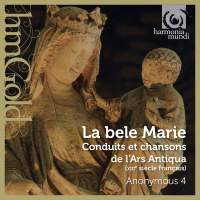Texte paru dans: / Appeared in: |
|
|
Outil de traduction |
|
|
|
|
|
Reviewer: J.
F. Weber I don’t think anyone has ever noticed a certain subtlety of this medieval vocal ensemble’s name. It’s not simply the adaptation of a familiar term invented by Coussemaker in 1864 to identify one of a series of unknown writers of the 13th century, applying the term as the name of a group of four singers who specialize in the repertoire of the period. It’s the distinction between Coussemaker’s “Anonymous IV” and this group’s term “Anonymous 4” that seems to have been overlooked. Coussemaker, the wily Frenchman, also changed the Latin names of two otherwise unsung composers that the medieval writer had identified as Leoninus and Perotinus. He chose to call them Léonin and Pérotin, although there are no contemporary records of those two French names that can be linked with certainty to the later writer’s description. I mention these two points only because in March I published an article about early polyphony to 1300 along with a list of records (not a “discography,” as it was titled). In connection with the Notre-Dame aspect of the music, I referred to Anonymous IV and his two composers, Leoninus and Perotinus, adding a remark that Coussemaker only invented the French forms in the 19th century. The points were badly obscured because the editor changed the name of the writer to Anonymous 4 (the form that belongs to the present vocal ensemble) and the names of the composers to the French forms (which made the subsequent remark about Coussemaker pointless). Even The New Grove Dictionary, Second Edition, has changed their entries from the French names used in 1980 to the Latin names. The 17 pieces on this program all date from the 13th century and honor the Blessed Virgin Mary. Four pieces are French songs, contrafacta of trouvère love songs, but the rest are Latin conductus, either monophonic or polyphonic. These were not exactly liturgical works, but they were sung during processions, as, for example, when the deacon was being conducted to the place where he would sing the gospel. The conductus come from the four most important sources of Notre-Dame polyphony and from the Codex Las Huelgas. The most familiar piece, the longest of all and placed dead center in the program, is the monophonic conductus Beata viscera, one of seven pieces (and the only monophonic one) identified by Anonymous IV as composed by Perotinus. Modern scholars have tried to identify other works as his on stylistic grounds. Some go so far as to assume that all the three- and four-part polyphonic works in the three principal manuscript sources associated with the cathedral of Notre-Dame must be his work, further assuming that all the two-part pieces belong to Leoninus. We hear only verses 1, 6, and 7 of Beata viscera, since the other verses can be read as anti-Semitic. (They can be found, however, on two other discs issued on this label, Paul Hillier’s HMU 907157 and Marcel Pérès’s HMC 901538.) Each member sings a solo chanson. They divide the polyphonic conductus among themselves, one voice to a part, and all sing the monophonic conductus together. Hence there is a constant variation of texture through the course of the program. Skipping through the tracks to hear each chanson in succession is a useful way of hearing the individual vocal quality of each member of the group, a move that had never occurred to me with their earlier discs. But that came only after hearing the program unfold as planned. These four ladies have an affinity for the spiritual nature of medieval music, evident not only in liturgical works (the larger part of their recorded output) but equally in other music that sprang from the same culture. They discover the depths of beauty that each of the poetic texts contains. This disc has the homogeneity characteristic of their two secular programs, Love’s Illusion and The Second Circle, not that there is anything wrong with the diversity of their other discs. In vocal production, programming, and presentation, there is hardly an ensemble in the whole field of early music that can touch them. This disc is a treasure. | |
|
|
|
|
|
|
|
Cliquez l'un ou l'autre
bouton pour découvrir bien d'autres critiques de CD |
|



